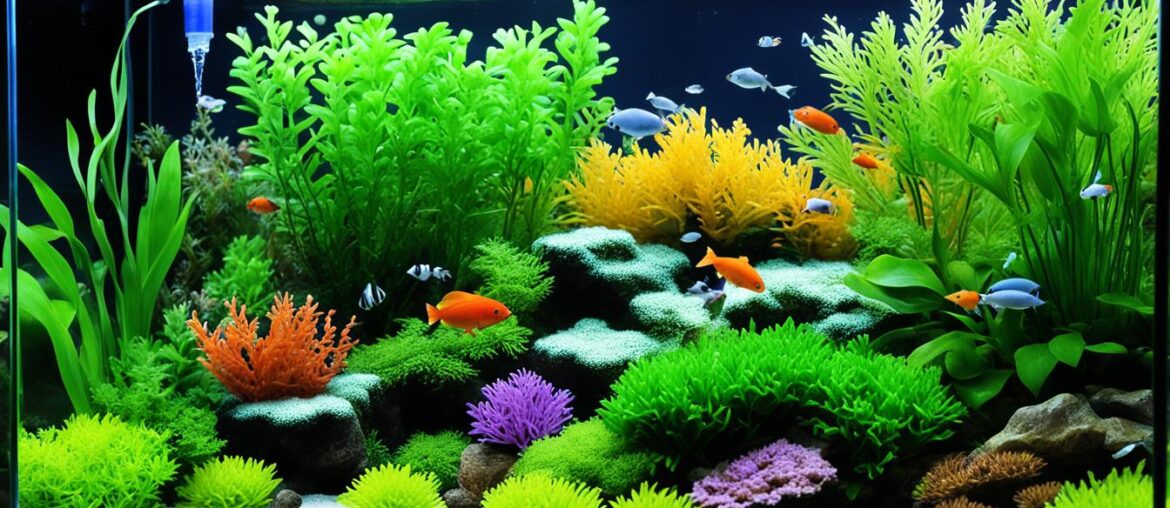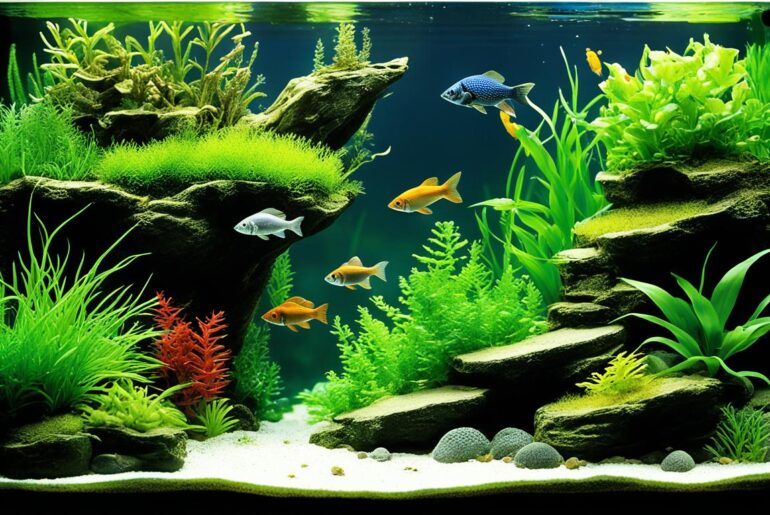Do you remember the first time you set up your aquarium? The anticipation of bringing new aquatic life into your home, the joy of carefully selecting vibrant fish, and the excitement of creating a beautiful underwater world. I still vividly recall the sense of wonder as I watched my fish explore their new habitat.
But there was something I didn’t fully understand at the time – the nitrogen cycle. It wasn’t until I experienced the consequences firsthand that I realized its importance.
One day, I noticed my fish becoming sluggish and discolored. Alarmed, I quickly researched what could be the cause. That’s when I discovered the crucial role of the nitrogen cycle in maintaining a healthy aquarium environment.
The nitrogen cycle is a natural process that turns fish waste into less harmful nitrogen compounds. It involves the work of beneficial bacteria, which help convert toxic ammonia into nitrites and eventually into nitrates. These nitrates are much less harmful to your fish than ammonia.
Establishing the nitrogen cycle in your aquarium is not only crucial for the well-being of your fish but also for the overall health and stability of your aquatic ecosystem. So, let’s dive in and learn the 10 steps to successfully establish your aquarium’s nitrogen cycle!
Key Takeaways:
- Establishing the nitrogen cycle is crucial for creating a healthy aquarium environment for your fish.
- The nitrogen cycle involves the conversion of fish waste into less harmful nitrogen compounds through beneficial bacteria.
- A successful nitrogen cycle helps remove toxic substances from the water and maintains water quality.
- Properly cycling your aquarium ensures a stable and healthy environment for your fish.
- Follow the 10 steps outlined in this article to establish your aquarium’s nitrogen cycle successfully.
Understanding the Nitrogen Cycle
The nitrogen cycle in an aquarium is a vital process that transforms fish waste into less toxic nitrogen compounds. This natural cycle plays a crucial role in maintaining water quality and ensuring the overall health of your fish.
When fish excrete waste, it produces ammonia, which can be harmful to fish if allowed to accumulate. However, beneficial bacteria in the aquarium play a vital role in converting ammonia into nitrites, a less toxic form of nitrogen compound. These nitrites are then further broken down by another group of bacteria into nitrates, the least toxic form of nitrogen compound.
By converting ammonia into nitrites and eventually nitrates, the nitrogen cycle helps to remove harmful substances from the water, creating a safe and healthy environment for your fish. This process mimics the natural filtration system found in aquatic ecosystems and is crucial for the long-term well-being of your aquarium.
It is important to understand and monitor the nitrogen cycle in your aquarium to ensure proper water quality. Regular testing using a reliable aquarium test kit will help you determine ammonia, nitrite, and nitrate levels, allowing you to take appropriate measures to maintain a balanced ecosystem within your fish tank.
“The nitrogen cycle is the cornerstone of a healthy aquarium. Understanding how it works is essential for any aquarium owner.” – John Smith, Aquarist
Importance of Cycling Your Aquarium
Cycling your aquarium is crucial for the well-being of your fish. If an aquarium is not properly cycled, harmful ammonia and nitrite levels can accumulate, leading to stress and disease in fish. Cycling allows beneficial bacteria to establish and maintain the nitrogen cycle, which helps remove toxic substances from the water. By cycling your aquarium, you create a stable and healthy environment for your aquatic friends.
Toxic ammonia and nitrites can have severe consequences for the delicate balance of your aquarium’s ecosystem. High levels of ammonia cause stress and discomfort for your fish, compromising their immune system and making them susceptible to diseases. Nitrites, another harmful byproduct of fish waste, can inhibit the capacity of blood cells to transport oxygen, putting additional stress on your fish’s respiratory system. This can lead to lethargy, reduced appetite, and even death.
Establishing a healthy nitrogen cycle is the key to avoiding these issues. The nitrogen cycle converts toxic ammonia into less harmful nitrites and then nitrates, completing the process of breaking down fish waste. Beneficial bacteria, like Nitrosomonas and Nitrobacter, play a vital role in this cycle by digesting ammonia and nitrites, effectively detoxifying your aquarium.
When you cycle your aquarium, you provide time for these beneficial bacteria to establish and thrive, ensuring a stable nitrogen cycle. This process typically takes a few weeks, during which you carefully monitor the ammonia and nitrite levels in your aquarium. As the beneficial bacteria multiply, they convert ammonia to nitrites and finally to nitrates, which are relatively less harmful to your fish.
The establishment of a nitrogen cycle is especially important for newly set-up aquariums or when introducing new fish to an existing aquarium. The presence of beneficial bacteria helps maintain water quality and prevent dangerous spikes in ammonia and nitrite levels that can harm your fish. Additionally, a stable nitrogen cycle reduces the need for frequent water changes and helps create a low-maintenance aquarium.
By cycling your aquarium and establishing a healthy nitrogen cycle, you create an environment that promotes the well-being and longevity of your fish. Maintaining stable water conditions is crucial for the overall health of your aquatic friends, enhancing their vibrant colors, promoting natural behavior, and reducing the risk of stress-related diseases.
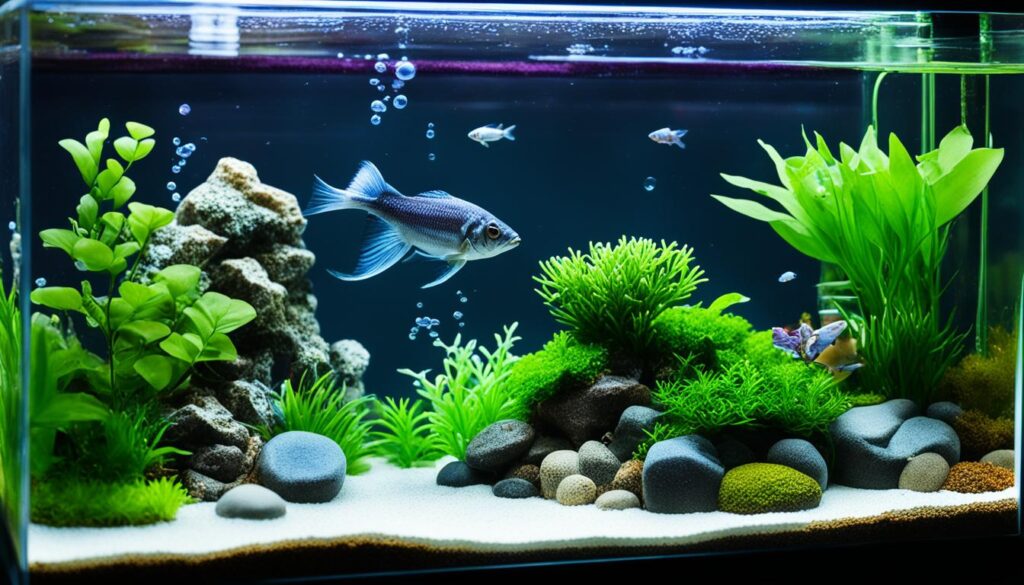
Key Benefits of Cycling Your Aquarium
- Reduces ammonia and nitrite levels, minimizing stress and disease in fish
- Promotes the growth of beneficial bacteria that maintain the nitrogen cycle
- Creates a stable and healthy environment for your fish
- Prevents dangerous spikes in ammonia and nitrite levels
- Reduces the need for frequent water changes
- Enhances fish colors and promotes natural behavior
Choosing the Right Fish for Cycling
When establishing the nitrogen cycle in your aquarium, selecting the appropriate fish to kickstart the process is crucial. Opting for hardy and resilient species ensures that they can withstand the ammonia and nitrite spikes that occur during the initial cycling phase. By starting with these fish, you can create a favorable environment for the establishment of the nitrogen cycle without causing harm to more delicate species.
- Cherry or Tiger Barbs: These lively and colorful fish are known for their adaptability to various water conditions.
- Banded Gourmis: With their hardy nature, these fish can thrive in diverse water parameters.
- White Clouds: These small, peaceful fish are excellent starter fish for cycling due to their tolerance for fluctuations in water quality.
- Zebra Danios: Robust and energetic, Zebra Danios can handle the cycling process and add a touch of beauty to your aquarium.
- Pseudotropheus Zebra: This species of cichlid is known for its resilience and adaptability, making it suitable for the cycling phase.
During the nitrogen cycle, these fish will help produce waste, providing a source of ammonia for the beneficial bacteria to convert. As the nitrogen cycle progresses and stabilizes, you can gradually introduce more sensitive fish species into your aquarium with confidence.
Choosing the right fish for cycling is essential to ensure the success of the nitrogen cycle. Opt for hardy species like Cherry or Tiger Barbs, Banded Gourmis, White Clouds, Zebra Danios, and Pseudotropheus Zebra. These fish can handle the ammonia and nitrite spikes during the cycling phase, setting the stage for a healthy and thriving aquarium.
| Fish Species | Hardiness | Water Tolerance | Temperament |
|---|---|---|---|
| Cherry or Tiger Barbs | High | Wide Range | Semi-aggressive |
| Banded Gourmis | Moderate | Varied | Peaceful |
| White Clouds | High | Variable | Peaceful |
| Zebra Danios | High | Wide Range | Active |
| Pseudotropheus Zebra | High | Varied | Territorial |
Adding Fish Food or Ammonia
To initiate the nitrogen cycle in your aquarium, there are two options: adding fish food or using pure ammonia. Both methods serve the purpose of simulating the release of ammonia, which is essential for kickstarting the nitrogen cycle.
Adding fish food is a natural way to introduce ammonia into the aquarium. As the fish food decomposes, it releases ammonia, mimicking the waste produced by fish. This method closely resembles what happens in a natural aquatic ecosystem.
If you prefer a more controlled approach, using pure ammonia is recommended. By adding a specific amount of pure ammonia to your aquarium, you can ensure a precise and consistent source of ammonia for the bacteria to feed on. This method allows you to have more control over the cycling process.
The choice between fish food and pure ammonia depends on your preference and the number of fish you plan to keep in your aquarium. If you opt for fish food, the dosage should be based on the number of fish you intend to have. On the other hand, when using pure ammonia, you can follow a precise dosing guide to achieve the desired ammonia level.
Using Fish Food:
- Add a small amount of fish food to your aquarium to ensure a gradual release of ammonia.
- Monitor the ammonia levels regularly using an aquarium test kit.
- Adjust the amount of fish food based on the ammonia levels, aiming for a range of 2-4 parts per million (ppm).
Using Pure Ammonia:
- Choose a pure ammonia product specifically designed for aquarium use.
- Follow the dosing instructions provided with the ammonia product to add the correct amount to your aquarium.
- Monitor the ammonia levels and adjust the dosage if needed to maintain the desired range of 2-4 ppm.
Adding fish food or ammonia will provide a source of ammonia for the beneficial bacteria to feed on, starting the nitrogen cycle in your aquarium. The choice between the two methods ultimately depends on your preference and the level of control you desire.
Remember to closely monitor ammonia levels throughout the cycling process to ensure the nitrogen cycle progresses smoothly.
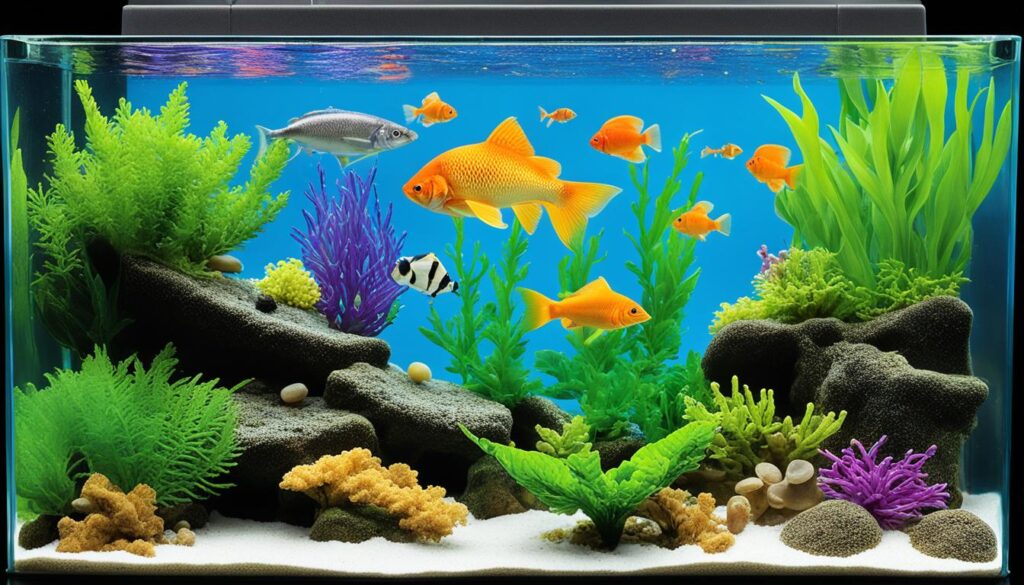
Monitoring Ammonia and Nitrite Levels
Throughout the cycling process, it is crucial to monitor ammonia and nitrite levels in your aquarium. By regularly testing and tracking these levels, you can ensure the progress of the nitrogen cycle and maintain a healthy environment for your fish.
Why is monitoring important?
Monitoring ammonia and nitrite levels allows you to assess the effectiveness of the nitrogen cycle and identify any potential issues early on. High levels of ammonia or nitrites can be toxic to fish, causing stress and harm to their health. By keeping a close eye on these levels, you can take the necessary steps to maintain a safe and stable environment for your aquatic friends.
Ammonia levels:
Ammonia levels should be maintained between 2 and 4 parts per million (ppm) during the cycling process. This range ensures that enough ammonia is present for the beneficial bacteria to consume, kickstarting the nitrogen cycle. Regular testing using a reliable aquarium test kit will help you determine the ammonia levels in your tank.
Nitrite levels:
The goal is to keep nitrite levels below 1 ppm as the nitrogen cycle progresses. Nitrites are produced when the beneficial bacteria convert ammonia into nitrites. While nitrites are less toxic than ammonia, high levels can still be harmful to fish. Regular testing will help you monitor nitrite levels and ensure they remain within safe limits.
Tip: If you notice ammonia or nitrite levels rising beyond the recommended ranges, partial water changes can help dilute these substances and alleviate stress on your fish. Consult your local aquarium professional for guidance.
Testing frequency:
During the early stages of the cycling process, it is advisable to test ammonia and nitrite levels every 1-2 days. As the nitrogen cycle progresses and conditions stabilize, testing can be done less frequently, approximately every 3-4 days. Regular testing will allow you to track the progress of the nitrogen cycle and make any necessary adjustments to ensure optimal conditions for your fish.
Choosing a reliable aquarium test kit:
To accurately measure ammonia and nitrite levels, invest in a high-quality aquarium test kit. These kits typically include test strips or liquid tests that provide accurate and easy-to-read results. Consult with your local aquarium store or read reviews to find a reliable test kit that suits your needs.
Keeping your fish safe:
By monitoring ammonia and nitrite levels during the nitrogen cycling process, you can provide a safe and healthy environment for your fish. Regular testing and adjustments, if needed, will ensure that the nitrogen cycle is progressing as it should, avoiding any harm to your aquatic friends.
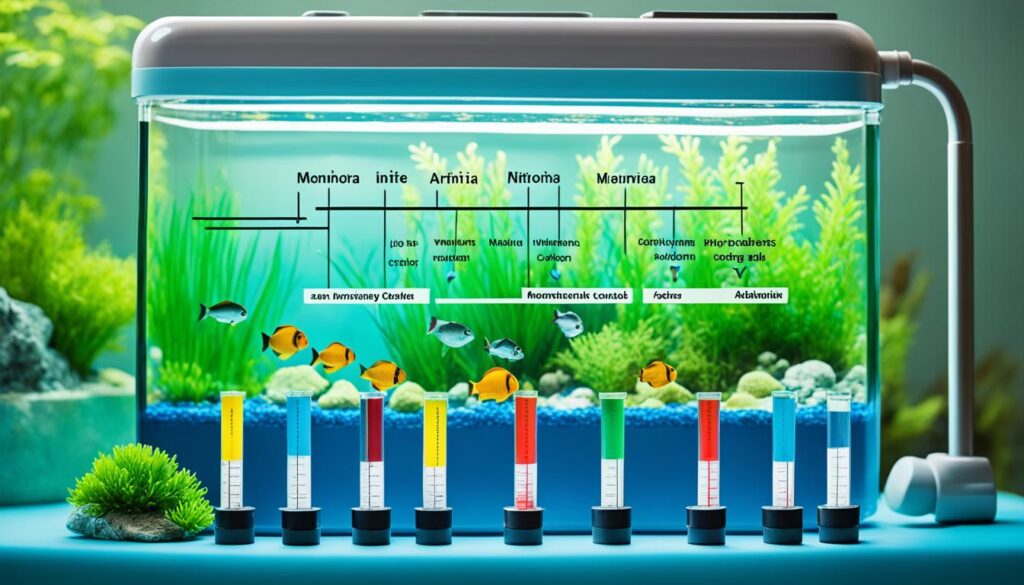
Allowing the Nitrogen Cycle to Complete
The nitrogen cycle is a natural process that takes time to establish in an aquarium. It typically takes four to eight weeks for the cycle to complete its course. During this period, beneficial bacteria gradually establish themselves and consume ammonia and nitrites, converting them into nitrates.
It is crucial to be patient and allow the cycle to run its course without rushing the process. Rushing the cycle can disrupt the bacteria’s growth and hinder the establishment of a stable nitrogen cycle. By giving the cycle enough time, you ensure the optimal conditions for the growth and effectiveness of the beneficial bacteria.
Monitoring the water parameters throughout the cycling process is essential. As the bacteria population grows, ammonia and nitrite levels will gradually decrease. Once ammonia and nitrite levels drop to zero, and nitrates are present, it is a clear indication that the nitrogen cycle has successfully completed.
Remember, the key to allowing the nitrogen cycle to complete is patience. Rushing it can disrupt the delicate balance of the aquarium ecosystem and lead to water quality issues and stressed fish. By giving the cycle the time it needs, you establish a healthy and thriving aquarium environment for your fish.
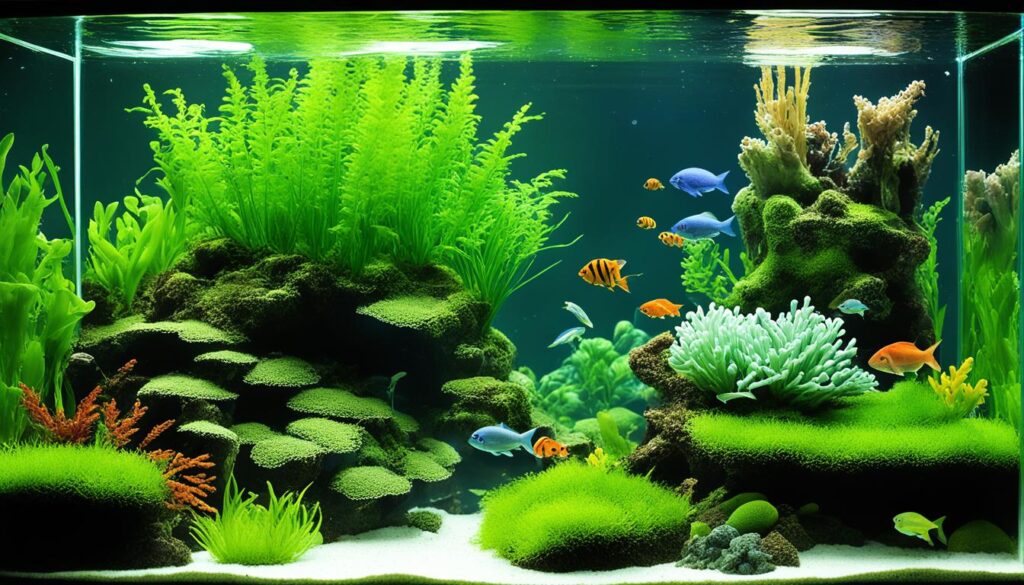
| Signs of a Completed Nitrogen Cycle |
|---|
| No detectable ammonia and nitrite levels |
| Presence of nitrates |
| Stable water parameters |
| Healthy and active fish |
| Clear and odorless water |
Performing Water Changes and Maintenance
As the nitrogen cycle progresses in your aquarium, nitrates, the least toxic nitrogen compound, will accumulate in the water. To maintain optimal water quality and ensure the health of your fish, it is essential to perform regular water changes and maintenance.
To reduce nitrate levels and replenish essential minerals and nutrients, consider conducting partial water changes of 20-50% every 1-4 weeks, depending on the stock levels in your aquarium. This will help remove accumulated nitrates and maintain a balanced environment for your aquatic friends.
Additionally, regular maintenance of filters, substrate, and other aquarium components is vital to ensure the continued effectiveness of the nitrogen cycle. Cleaning or replacing filter media, siphoning the substrate to remove debris, and checking equipment for any issues will help keep your aquarium running smoothly.
To summarize, performing regular water changes and maintenance is a crucial part of maintaining a healthy nitrogen cycle in your aquarium. It helps control nitrate levels, provides essential nutrients, and ensures the overall well-being of your fish.
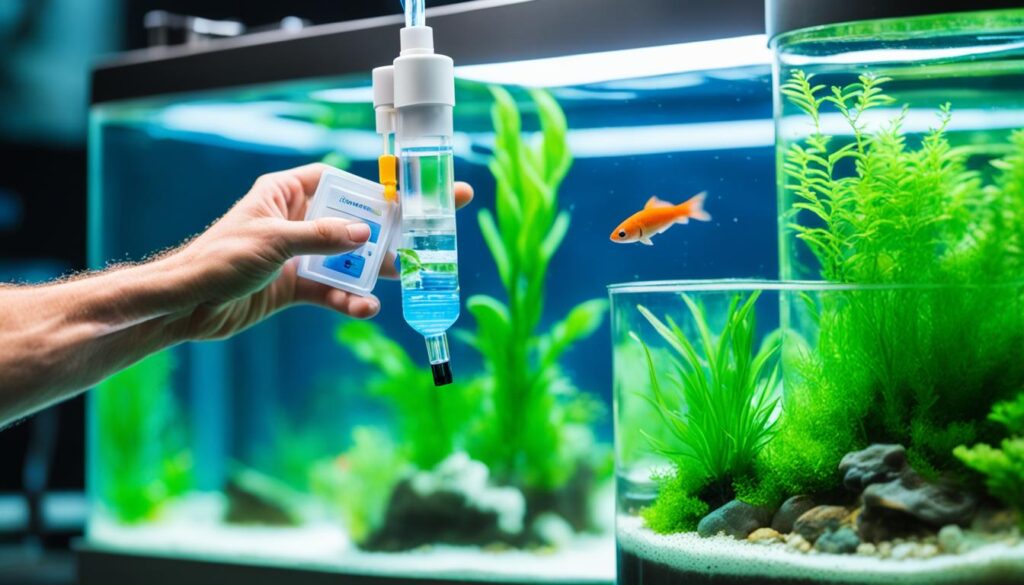
Tips for Water Changes and Maintenance:
- Use a siphon or gravel vacuum to remove debris from the substrate during water changes.
- Test the water parameters regularly to monitor the effectiveness of the nitrogen cycle and identify any potential issues.
- When performing water changes, use a dechlorinator to neutralize harmful chemicals in tap water.
- Clean or replace filter media according to the manufacturer’s recommendations to maintain optimal filtration.
- Keep an eye out for any signs of equipment malfunction or leaks and address them promptly.
By following these tips and incorporating regular water changes and maintenance into your aquarium care routine, you can ensure a healthy nitrogen cycle and provide the best possible environment for your beloved fish.
Conclusion
Establishing the nitrogen cycle in your aquarium is a crucial step in creating a healthy and thriving aquatic environment for your fish. By following the 10 steps outlined in this article, you can ensure that the nitrogen cycle in your aquarium is properly established.
Remember to be patient and monitor the levels of ammonia and nitrites throughout the cycling process. This will help you track the progress of the nitrogen cycle and ensure the well-being of your fish.
Once the nitrogen cycle is successfully established, you can enjoy a beautiful aquarium that provides a safe and comfortable home for your fish. So, take the necessary steps to set up and maintain the nitrogen cycle, and watch your aquatic world thrive!
FAQ
What is the nitrogen cycle in an aquarium?
The nitrogen cycle in an aquarium describes the natural process by which fish waste is converted into less toxic nitrogen compounds through the actions of beneficial bacteria.
Why is cycling your aquarium important?
Cycling your aquarium is crucial for the well-being of your fish. It allows beneficial bacteria to establish and maintain the nitrogen cycle, which helps remove toxic substances from the water and creates a stable and healthy environment for your fish.
What fish should I choose to kickstart the nitrogen cycle?
It is important to choose hardy and resilient fish, such as Cherry or Tiger Barbs, Banded Gourmis, White Clouds, Zebra Danios, and Pseudotrophius Zebra. These fish can withstand the ammonia and nitrite spikes that occur during the cycling phase.
Should I add fish food or ammonia to initiate the nitrogen cycle?
You can either add fish food or pure ammonia to your aquarium to initiate the nitrogen cycle. Fish food simulates the release of ammonia from fish waste, while pure ammonia provides a controlled source. The dosage should be based on the number of fish you plan to have in your aquarium.
How do I monitor ammonia and nitrite levels during the cycling process?
It is crucial to regularly test ammonia and nitrite levels in your aquarium using a reliable aquarium test kit. Ammonia levels should be maintained between 2 and 4 parts per million (ppm), while nitrite levels should be kept below 1 ppm.
How long does the nitrogen cycle take to complete?
The nitrogen cycle typically takes four to eight weeks to complete. During this time, beneficial bacteria will gradually establish and convert ammonia and nitrites into nitrates.
How often should I perform water changes and maintenance?
Regular partial water changes of 20-50% should be performed every 1-4 weeks, depending on the stock levels. This helps reduce nitrate levels and maintain water quality. Regular maintenance of filters, substrate, and other aquarium components is also important.
